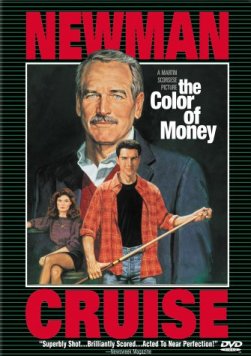FILM NOTES
FILM NOTES INDEX
NYS WRITERS INSTITUTE
HOME PAGE

 The Color of Money
The Color of Money
(Unitd States, 1986, 119 minutes, color, 16mm)
Directed by Martin Scorsese
Cast:
Paul Newman . . . . . . . . . . "Fast Eddie" Felson
Tom Cruise . . . . . . . . . . Vincent Lauria
Mary Elizabeth Mastrantonio . . . . . . . . . .Carmen
Helen Shaver . . . . . . . . . . Janelle
The
following film notes were prepared for the New York State Writers
Institute by Kevin Jack Hagopian, Senior Lecturer in Media Studies
at Pennsylvania State University:
His name is "Fast Eddie" Felson, and in 1961, as played by Paul Newman in Robert Rossen’s film The Hustler, he incarnates a distinctively American tragedy. Eddie’s medium is pool, and he plays the game like Picasso painted, in bold new strokes that seem to criticize the way everyone else plays. Slick and smirking, Eddie sees others only as impediments to his own success. Ethics is a big gag to Eddie, who sets people up like a fresh rack of balls.
But then he meets his match in a dapper fat man, a Zeus of the billiard table, and a wounded young woman, Sarah Packard (played by Piper Laurie) whose weaknesses are a mirror for his own. Eddie’s slow comeback from his defeat at the hands of Fats (memorably played by Jackie Gleason) has as much to do with life as with pool, and by the end of the film, Fast Eddie has learned something about the fragility of the human ego. He may shoot a great game of pool, but he’ll never again be able to treat other souls like a cheap one-cushion bank shot.
Fast-forward 25 years. The Color of Money. Fast Eddie is still fast, but his speed is relative. Now, he’s a middle-aged sharpie in a loud jacket with a wine-colored Cadillac who’s landed, inevitably, in the liquor business. He’s become a fixture on his circuit of bars and package joints. He can still shoot a fearsome game of pool, but he’s less driven to conquer than he once was. The world around him has changed, too. Gone are the great sacred churches of the game, like Ames’ billiard hall in New York. Gone, too, are the smaller pool emporiums at the edges of decaying downtowns, where a hustler like Eddie could set up the local hot shots and then take them down, methodically and cleanly and quietly, over the course of a long, hot afternoon. Now, there are just the bars, the loud, smoky bars with the threat of drunken danger looming over the tables. In this new world, pool has gone from being a ritual conducted in a temple among a respectful crowd of apostles, to a brute contest in front of louts who’ll never have the patience to learn the game as Eddie learned it.
Richard Price and Martin Scorcese’s The Color of Money is less a sequel than a jazz riff on a great theme, that of the knowledge that springs from contesting greatness, man against man. In filmmaking terms, the question becomes, "what would a character look like after learning the profound lessons of the earlier film? For Price and Scorcese, that character looks like a man who has retracted his great talent, having beaten all the people worth beating, including himself, until Vincent Lauria (Tom Cruise), a young man who reminds him of himself when young, turns up, and whose greatness is a challenge to Eddie. Everything about Vincent is preposterous, from his goofy martial arts moves with his cue to his over-elaborate trick shots; even his hair seems to swagger. Eddie wonders: is there anything he can teach this punk? That turns into a question straight out of the Catechism: can Eddie make the kid so good that even Eddie can’t beat him? Eddie, remembering the example of Charlie Burns (Myron McCormick) in The Hustler, plays mentor to the cocky Vincent. But he has to force himself into Vincent’s life, for this is a generation whose respect for their elders is perhaps even shallower than young Eddie’s had been, back in the day…
The world of Richard Price and Martin Scorcese is one of urban sin and retribution, the world of Price’s The Wanderers and Scorcese’s Mean Streets; their collaboration as screenwriter and director now seems inevitable. The Color of Money matches Price’s words to Scorcese’s camera to tell a story of rivalry that is so familiar to both. Eddie begins as Vincent’s teacher and the father Vincent is glad he never had, but winds up as he must, colliding with Vincent at the pool table. Of course, The Color of Money isn’t about pool, or even about money. "You gotta be a student of human beings… That’s my area of excellence," says Eddie to Vincent, in a reflective moment. From Eddie, Vincent learns to dope out his adversaries. From his war with Vincent, Eddie will learn to complete the process of self-analysis he unwillingly began that night long ago, under the lights at Ames…
— Kevin Hagopian, Penn State University
For additional information, contact the Writers Institute at 518-442-5620 or online at https://www.albany.edu/writers-inst.